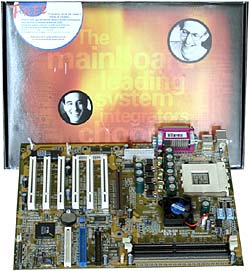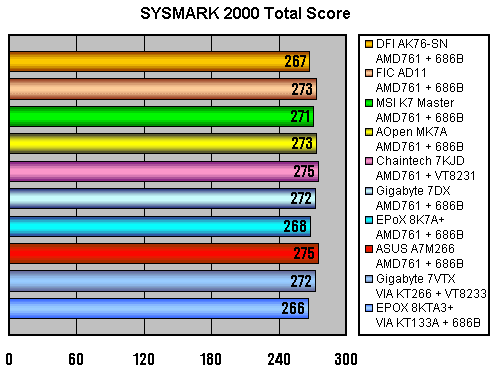 |
||
|
||
| ||
As a company grows the number of motherboard vendors, we are working with, is also getting larger. As a result, when conducting one or another comparative testing, some of manufacturers fail to give in time their mainboards for testing. On the other hand, the companies happened to be in a worse position mustn't be ignored. That is why we have decided upon updating of such articles if new boards appear and the review keeps its urgency, with the test conditions being the same as in the main part. And we are going to try such approach on DFI, one of the oldest companies on the motherboard market founded in 1981. On the whole, the list of companies which have become partners of ATI in manufacturing video adapters on its chips is quite strange because the most part of them is hardly connected with production of video adapters. Presence of DFI in this list is also unusual. But it turned out that in 1985 this company was in top 5 of video card makers in Taiwan. DFI produces not only mainboards, it covers the range from video cards and CD-drives to rack-mount servers, NAS devices and other devices. Besides, DFI includes firms dealing with development and production of industrial computers. At www.dfi.com you can find the whole spectrum of its products. But mainboards are the major products here. DFI makes more than 200,000 boards a month, thus taking the place among ten best Taiwanese mobo manufacturers. Initially the company aimed the American market. But now it's also looking at the Europe. But now let's return to the DFI AK76-SN board based on the AMD761+VIA 686B chipset. Yet a month ago in the comparative review all board performed very well. Therefore, we shouldn't make an allowance for the DFI either.  The board is packed in black and orange package. Such design is trendy for the West today. MB companies understand that a beautiful box is a considerable part of marketing. Specification
The board ships with FDD and 80-conductor IDE cables, a CD with drivers and antivirus programs, a detailed user's manual and a sticker with a detailed description of components of the board, functions of jumpers and DIP switches. Besides, in the box you can find a sheet of paper with specs of the board, a press-release of 9 March, a guide on how and in what color the logotype "DFI" must be written and note-paper with the same logotype. The board suits well the conception of an entry-level workstation as it's specified for AMD760 based mainboards. Everything that is useless in a serious work - AC'97 sound, RiserCard slot - is not realized. On the other hand, the board features 6 PCI slots, 5 connectors for coolers. Since the monitoring means integrated into the south bridge allow monitoring only two rotational speeds, those two connectors which are linked with the monitoring means are made of while plastic, while other two are of brown one. The only disadvantage is presence of an AGP slot, although the AGP Pro would have been more appropriate here. The voltage changers unit uses a three-phase feed circuit implemented at the high level. The power supply connector is located near the place usually used for a game-port. On the one hand, it may cause difficulties when installing power supply units with short cables, but since the connector is located close to the voltage changers unit additional pickups are prevented. By the way, many ask how to make sure the power supply unit is high-quality, if we can't switch it on and, for example, listen to a fan... The first way is to buy Brand-name products, e.g. from DELTA, AOpen, PowerMan. But if the manufacturer is unknown, just check its weight. If a unit is heavy, then you can be sure it contains a large transformer and massive heatsinks. For example, a 300W power supply unit from AOpen weighs more than 2 kg. Another aspect is a length of cables. Good manufacturers never save on them. Of course, the advise is primitive but it works in 99% of cases.  The board's stability is almost ideal, partially due to a heatsink mounted on the chipset and equipped with a fan. The socket is position conveniently; its side where coolers are clamped is turned to the board's edge and moved closely to it. Capacitors, being located far from the Socket-A, allow installing any cooler. 2 units of DIP switches are used for forced changing of the processor multiplier in the range from 5 to 12.5, and of the processor voltage from 1.475V to 1.850V in 0.025V steps. IDE and FDD connectors are located on the left side of the board parallel to PCI slots, right in the middle of each pair of PCI slots. Such position is rather convenient since it doesn't hamper installation of full-sized cards, and connectors are not gathered in one heap. On the whole, positioning of the components is competent and rouses no censure. That is why we mustn't face any problems when installing it in the case. Recently manufacturers installed additional USB connectors near external ports. At present case makers provide space for two USB ports on the front panel. That is why USB connectors have moved to DIMMs and IDE connectors. The FSB frequency can be changed with three jumpers which, though, can be replaced with one. The BIOS is based on the AWARD 6.0. You can change the bus frequency from 100 to 166 MHz in 1 MHz steps and adjust memory timings. Test platformTest system configuration:
Software:
Test results  As far as the performance is concerned the board falls behind the leaders of the review - FIC, ASUS and MSI, but the difference makes only several percents: it's insignificant. The stability and correspondence to the conception is much more important. ConclusionTaking into account that DFI produces a wide range of products from the cheapest boards to Pentium 4 based ones and a competent price policy, I can state that its products will be very popular among consumers. [ The results of other AMD760 based mainboards can be found here ] Write a comment below. No registration needed!
|
Platform · Video · Multimedia · Mobile · Other || About us & Privacy policy · Twitter · Facebook Copyright © Byrds Research & Publishing, Ltd., 1997–2011. All rights reserved. |